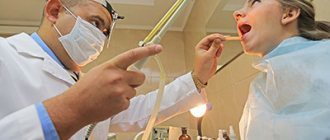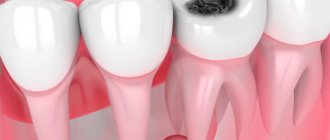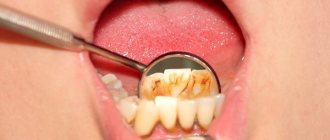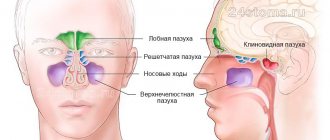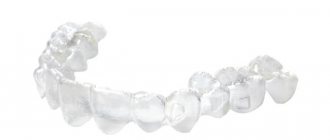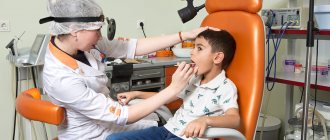Angina
is an acute infectious disease that causes inflammation of the tonsils.
Another name for the disease is acute tonsillitis
(from the Latin word tonsillae - “tonsils”).
The palatine tonsils (popularly called tonsils) are an outpost of our immune system. It is here that the body's defenses give the first resistance to pathogenic bacteria and viruses that enter the oropharynx along with food and air.
Tonsils are ovoid-shaped glands (in their shape they resemble an almond nut, hence the name), formed by lymphoid tissue. Lymphoid tissue has two main functions - hematopoietic and protective. The tonsils produce lymphocytes, the main cells of the immune system that provide humoral immunity, that is, the production of antibodies. Also in the tonsils there are macrophages - cells that envelop and destroy foreign microorganisms. The palatine tonsils are dotted with crypts - canals that begin on the surface and go deep into the body of the tonsils. These channels work as traps for foreign agents, entering which they are, firstly, destroyed, and secondly, antibodies are produced to them, which are then carried by the bloodstream throughout the body. Therefore, the situation in the tonsils is always on the verge of an inflammatory process. And if the body’s immune defense is weakened for some reason (for example, as a result of frequent colds) or the infection turns out to be particularly “aggressive,” inflammation in the tonsils becomes pathological. And since the tonsils are responsible for the immunity itself, the consequences of the disease can affect the entire body. This is what makes sore throat a dangerous disease.
Causes of sore throat
Children often suffer from tonsillitis. This is due to the fact that in children, the tonsils are just being formed, and, therefore, the body’s protective reaction is not yet complete. And after 35-40 years, the disease, as a rule, does not occur - the lymphoid tissue that makes up the palatine tonsils begins to atrophy; In old age, tonsils disappear.
The causative agents of sore throat in most cases are bacteria. However, it can be caused by either a virus or a fungus. Inflammation can be superficial (catarrhal tonsillitis), or it can spread deep into the body of the tonsils. Suppuration of the crypts with which the tonsils are dotted leads to a more severe form of the disease (lacunar tonsillitis; lacunae are the mouths through which the crypts open onto the surface of the tonsils). The most severe form of the disease is follicular tonsillitis, when the follicles become inflamed - lymph nodes located throughout the body of the tonsils (both on the surface and in the depths). Inflammation may not be limited only to the palatine tonsils, but may spread to neighboring tissues and other organs. In other words, the name sore throat hides a whole “bouquet” of diseases, which only a doctor can understand and correctly determine the necessary course of treatment.
Bacteria that cause sore throat are widespread and cause many other diseases. Therefore, the source of infection can be a person who is not necessarily suffering from a sore throat. He may not have an acute form of the disease at all; it is enough that he is a carrier of pathogenic bacteria.
Very often, sore throat comes not from the outside, but from within the body. We ourselves are carriers of these bacteria. Inflammatory processes in the tonsils in a non-acute form can last for months, or even years. In this case, they talk about chronic tonsillitis. In the presence of chronic tonsillitis, tonsillitis is its exacerbation. Exacerbation is facilitated by hypothermia or weakening of the body. If a person often gets a sore throat, then most likely he has chronic tonsillitis.
Sources
- Alieva A.A., Harseeva G.G., Mangutov JO., Golovin S.N. // Klin Lab Diagn - 2021 - Vol63 - N6 - p.375-378; PMID:30702232
- Nomikos M., Barmpoutis P., Papakonstantinou E., Chousianitis Z., Ouzounoglou P., Efstathiadou P., Katsifotis C. A giant verrucous carcinoma of the penis presenting with urinary sepsis and angina. // Case Rep Med - 2014 - Vol2014 - NNULL - p.207026; PMID:25477967
- Dajer-Fadel WL., Borrego-Borrego R., Flores-Calderón O., Argüero-Sánchez R., Navarro-Reynoso FP., Ibarra-Pérez C. Descending necrotizing mediastinitis associated with spinal cord abscess. // Asian Cardiovasc Thorac Ann - 2013 - Vol21 - N1 - p.90-2; PMID:23430432
- Oda T., Yasunaga H., Matsumura Y., Watanabe G., Zaima Y., Takaseya T., Wada Y. Coronary artery bypass grafting in a patient with unstable angina pectoris and bronchiectasis. // Ann Thorac Cardiovasc Surg - 2014 - Vol20 Suppl - NNULL - p.761-4; PMID:23364226
- Dedov II., Terekhin SA., Kalashnikov VIu., Mitish VA., Doronina LP., Tokmakova AIu., Galstian GR., Melkozerov KV., Peretokina EV. [Single-step endovascular revascularization of the kidney, lower limb and endovascular reconstruction of abdominal aortic aneurysm in a patient with type 2 diabetic mellitus]. // Angiol Sosud Khir - 2012 - Vol18 - N3 - p.51-6; PMID:23059607
Symptoms of a sore throat
The feeling of illness comes suddenly. The patient feels severe pain in the throat and the temperature rises sharply. A rise in temperature may be preceded by chills.
When examining the throat, redness of the tonsils is observed. The tonsils increase in size (swell). The lymph nodes in the submandibular region are enlarged.
With lacunar angina, the lacunae of the tonsils are enlarged, and purulent masses accumulate in them. A film-like coating is visible on the tonsils. Body temperature can reach 40°C.
In the case of follicular tonsillitis, when examining the tonsils, spherical yellow formations are visible - this is what inflamed follicles look like. Swelling of the regional lymph nodes is extremely pronounced. Sometimes there is swelling of the soft tissue on the side of the affected tonsil.
Sore throat in any form, and especially lacunar and follicular, leads to general intoxication. The waste products of pathogenic microbes are absorbed into the blood and spread throughout the body. The tissue of blood vessels, nervous system, kidneys, liver, and heart may be affected. The most common symptoms of intoxication are headache and general weakness.
A sore throat
Sore throat with sore throat corresponds to the degree of inflammation. Most often, with a sore throat, there is an aching pain in the throat, which gets worse when swallowing. The pain may radiate (give) to the ear area.
Temperature increase
Sore throat is characterized by a sharp increase in temperature. The temperature rises to 38°C and above.
Headache
Headache with sore throat is a consequence of intoxication. Pathogenic microorganisms that cause inflammation in the tonsils produce substances that are toxins for humans, poisoning the body, disrupting the functioning of its organs and systems. These toxins irritate the nerve endings and fibers of the cranial nerves, causing headaches.
More about the symptom
Weakness
General weakness with sore throat is another consequence of intoxication. Toxins accumulate in the muscles, reducing the activity of muscle contractions, causing muscle pain (myalgia), and aches throughout the body. They also disrupt the functioning of the central nervous system, causing drowsiness and apathy.
More about the symptom
Methods for diagnosing angina
To prescribe an effective course of treatment, correct diagnosis is of great importance. Acute inflammation of the tonsils can be a sign not only of sore throat, but also of mononucleosis, scarlet fever, diphtheria, leukemia and some other diseases. Therefore, if you have a sore throat against the background of a rise in temperature, you should not self-medicate, but consult a doctor.
Pharyngoscopy
Pharyngoscopy is a visual examination of the throat mucosa. Allows the doctor to assess the condition of the mucous membrane. The diagnosis of “angina” in most cases is made based on the results of pharyngoscopy.
More information about the diagnostic method
Bacteriological culture
Bacteriological culture allows you to identify the pathogen that caused inflammation of the tonsils. For analysis, discharge taken from the area of inflammation is used. The material is placed in an environment favorable to pathogenic microorganisms. Multiplying microorganisms allow us to conclude that this type of pathogenic microorganism is present in the area of inflammation.
ASLO - blood test for antibodies to streptococcus
The analysis shows the level of antibodies to streptococcus in the blood. Exceeding the norm indicates a previous streptococcal infection. A slight excess, as a rule, indicates that the person has had a streptococcal infection for a long time. High rates indicate recent infection.
Allows you to confirm the bacterial nature of the sore throat.
Sign up for diagnostics To accurately diagnose the disease, make an appointment with specialists from the Family Doctor network.
How to treat sore throat in an adult?
Treatment of angina symptoms in adults and children includes measures to combat infection, eliminate symptoms of the disease, and prevent recurrences.
In the acute period, it is recommended to adhere to bed rest. It is forbidden to consume cold drinks and foods that irritate the mucous membranes. A gentle diet speeds up recovery and reduces signs of local inflammation. Walking is allowed only in the absence of fever, if the weather is good - no wind, rain, or severe frost. It is necessary to frequently ventilate the room, carry out wet cleaning, and drink as much as possible.
Local treatment
antiseptic and anti-inflammatory drugs helps to quickly get rid of pain, reduce signs of inflammation, and improve overall well-being. For example, in the process of washing the tonsils with antiseptic solutions, the pus is washed away and signs of inflammation are reduced. If a bacterial pathogen is identified (in particular, BSGA), antibacterial drugs can be used. But you shouldn’t prescribe them to yourself. Uncontrolled self-use of antibiotics can lead to disruption of microflora and suppression of the immune system, which causes severe complications of the disease. In extreme cases, surgical intervention is resorted to. Hypertrophied tissues are removed, thereby ridding the body of the source of chronic infection.
Do not forget about the importance of local immunity.
He must always be ready to repel the attack of viruses and bacteria. To support local immunity for preventive purposes, adults and adolescents over 14 years of age use Imudon® 6 tablets per day for 20 days. The tablets dissolve, and it is not recommended to eat or drink for about an hour after using the drug6.
Instructions
More details
1 - Kochetkov P. A. Angina and acute pharyngitis / P. A. Kochetkov, A. S. Lopatin // Practical Pulmonology.. - 2005. - No. 3. - 8-14 p. 2 - Varlamov R. K. Angina. Symptoms, treatment and features of the course of the disease / R. K. Varlamov // Integration processes in science in modern conditions. Collection of articles of the International Scientific and Practical Conference. – 2021. – 120-123 p. 3 — Kunelskaya N. L. Angina: diagnosis and treatment / N. L. Kunelskaya, A. B. Turovsky, Yu. S. Kudryavtseva // Medical Affairs. – 2010. – No. 3. – 1-9 s. 4 - Pyshny D.V. Angina and tonsillopharyngitis: differences, prevention, treatment / D.V. Pyshny // New pharmacy. Pharmacy assortment. – 2008. – No. 2. – 7-11 p. 5 — Nikolaevskaya V. P. Chronic tonsillitis. Etiology, pathogenesis, clinic // Medicine. – Moscow, 1989. 6 — Instructions for medical use of the drug Imudon® lozenges dated 07/02/2018 The material was developed with the support of Abbott in order to increase patient awareness of their health status. The information in the material is not a substitute for healthcare advice. Contact your doctor. RUIMD191614 dated 06/26/2019.
Treatment methods for sore throat
First of all, local treatment is carried out for angina. Such treatment (gargles, lozenges) will help reduce sore throat and reduce the severity of inflammation. Rinsing is preferable, since in this case pus, pathogenic microbes and their metabolic products are not swallowed, but are washed out of the tonsils and spat out.
However, in many cases, it is impossible to cure a sore throat with local treatment alone. Therefore, as a rule, treatment of sore throat includes a course of antibiotics. The duration of medication is determined by the doctor. Unauthorized discontinuation of the prescribed drug after the severity of symptoms in the case of a sore throat has subsided can result in serious complications. You should also not take antibiotics without a doctor's prescription.
Antibacterial therapy
Antibiotics are used to treat sore throat if it is caused by a bacterial infection. The course of treatment must be prescribed by a doctor. Self-medication with antibiotics is unacceptable.
More information about the treatment method
Make an appointment Do not self-medicate. Contact our specialists who will correctly diagnose and prescribe treatment.
Rate how useful the material was
thank you for rating
Treatment of chronic tonsillitis
Chronic tonsillitis is treated using both conservative and surgical methods.
Conservative methods are:
- antibiotics that are prescribed both locally (gargling) and systemically (tablet or injection forms);
- direct washing of lacunae and introduction of antibacterial and anti-inflammatory drugs into them;
- physiotherapeutic procedures (hallotherapy, magnetic laser treatment of lymph nodes, phonophoresis and ultraviolet irradiation of the palatine tonsils).
| Treatment method | Mechanism of action | Target |
| Irrigation of lacunae using a cannula | The lacunae are cleaned of pus, microorganisms, food debris, and epidermal plugs using a jet of antiseptic solution. In the future, an antibacterial and anti-inflammatory drug may be administered | Cleansing lacunae Bactericidal effect Anti-inflammatory effect |
| Washing lacunae using a vacuum nozzle | Due to the action of vacuum, the contents are removed from the lacunae. | Cleaning gaps |
| Magnetic laser therapy (MILTA) | The effect of a magnetic field and laser radiation on the area of inflammation. The microcirculation of the affected area improves, and the local protective properties of the mucous membrane are activated. | Anti-inflammatory effect Activation of local immunity |
| Phonophoresismedicines | The effect of drugs (antibacterial, anti-inflammatory) on the mucous membrane of the tonsils. Under the influence of ultrasound, drugs penetrate into the deep sections of the lacunae. | Anti-inflammatory effect Bactericidal effect |
| Ultraviolet radiation (UV) | Ultraviolet radiation has a bactericidal effect and activates local immunity of the mucous membrane. | Bactericidal effect Activation of local immunity |
Surgical treatment methods:
- Tonsillectomy – removal of the tonsils along with the capsule (instrumental and bloodless technique).
- Destruction of lymphoid tissue in the tonsil (radio wave ablation, cryodestruction).
- Cryptolysis (“soldering” of palatal lacunae).
| Method of therapy | Mechanism of action | Advantages | Indications |
| Tonsillectomy performed with traditional instruments (instrumental) | Isolation of the tonsil and its capsule is carried out with surgical instruments (loop, raspatory) | Speed of surgery | Previous treatment was ineffective. Beta-hemolytic streptococcus was detected. Toxic-allergic form of tonsillitis. |
| Tonsillectomy bloodless | The tonsil is released from the capsule using a laser, radio wave, cold plasma energy or other physical methods | Simultaneous dissection and coagulation of tissue. The intervention is bloodless | Previous treatment was ineffective. Beta-type hemolytic streptococcus was detected. Toxic-allergic form of tonsillitis. |
| Destruction (ablation) of the lymphoid elements of the tonsil | Radio waves, laser, high or low temperatures destroy most of the lymphoid structures of the tonsils | Can be carried out in a clinic setting | Previous treatment was ineffective Simple (catarrhal) form of tonsillitis |
| Cryptolysis | Destruction of the epithelial layer of lacunae due to physical methods of influence. Under such conditions, they stick together, so food particles and microorganisms do not penetrate there, i.e. inflammation cannot develop. | Can be carried out in outpatient settings | Previous treatment was ineffective Simple (catarrhal) form of tonsillitis |

